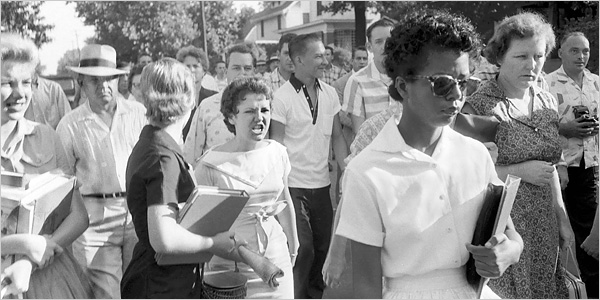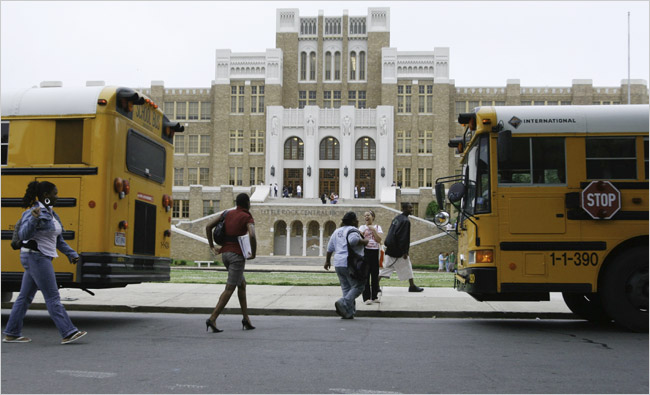| Want to send this page or a link to a friend? Click on mail at the top of this window. |
More Special Reports |
| Posted May 9, 2007 |
50 Years Later, Little Rock Can't Escape Race |
|
 |
|
Will Counts/Associated Press |
|
| Black students like Elizabeth Eckford faced hatred to integrate Central High in Little Rock, Ark., in 1957. Today white school board members are supporting an embattled black superintendent. |
____________ |
|
By KIM SEVERSON |
LITTLE ROCK, Ark. — Fifty years after the epic desegregation struggle at Central High School, the school district here is still riven by racial conflict, casting a pall on this year’s ambitious commemorative efforts.
In the latest clash, white parents pack school board meetings to support the embattled superintendent, Roy Brooks, who is black. The blacks among the school board members look on grimly, determined to use their new majority to oust him. Whites insist that test scores and enrollment have improved under the brusque, hard-charging Mr. Brooks; blacks on the board are furious that he has cut the number of office and other non-teaching jobs and closed some schools.
The fight is all the more disturbing to some here because it erupted just as a federal judge declared Little Rock’s schools finally desegregated, 50 years after a jeering white mob massed outside Central High to turn back integration.
In 1957, the fight was over whether nine black students could attend an entirely white high school. Now it is over whether the city’s black leaders can exert firm control over the direction and perquisites of an urban school district in the way that white leaders did for decades. When Mr. Brooks, who declined a request for an interview, cut 100 jobs, he saved money but earned the fierce ill will of many other blacks, who see the district as an important source of employment and middle-class stability.
Many whites, on the other hand, see the district, where issues of race have long been a constant backdrop, as a bloated bureaucracy, ripe for Mr. Brooks’s pruning. Where some blacks say Mr. Brooks disregards them and cozies up to the white business establishment, many whites say he is merely trying to stop white flight.
The bitter racial split has left some residents questioning the dimensions of advancement in the intervening years. There are no mobs in the street this time, but the undercurrents are nasty.
“We’re quite concerned about what kind of progress we have or haven’t made,” said Andre Guerrero, a white member of the Central High School 50th Anniversary Commission.
“This is a power struggle about whose voice is going to prevail,” Mr. Guerrero said as the school board prepared to meet last week. Mr. Brooks’s tenure and the fight over him has thrown the district into turmoil.
“I’ve never seen anything like this — the divisiveness, the hate,” said the leader of the teacher’s union, Katherine Wright Knight. Another outspoken critic, Katherine Mitchell, the board president, said, “I’m saying, we have really regressed.”
____________ |
|
| Racial lines are crossed in a fight over a superintendent's job performance. | |
____________ |
The judge’s ruling in February, disputed by activists and black board members but welcomed by Mr. Brooks, freed the city’s schools from federal oversight. It marked the end of a government engagement that began in September 1957 when Army soldiers escorted the nine black students up the stone steps of Central High.
But it did not end longstanding resentments, and after a black majority was elected to the board for the first time last fall, the gloves are off.
Other urban public school districts in the South have suffered through similar racial battles over leadership, aggravated by symptoms that prevail here, too: white flight, inner-city poverty and what is referred to as the “achievement gap,” the wide divergence in test results between white and black students. The gap fuels resentment and makes an anathema of any perceived administrative leaning toward white students.
The fight here has been especially bruising because of its symbolic overtones and practical implications. Though whites have deserted the schools in many other Southern cities, they have not done so to the same degree in Little Rock, where they make up about a quarter of the 23,000 students. Birmingham, Ala.; Jackson, Miss.; New Orleans and Memphis, by contrast, had white percentages in the single digits or barely above, according to 2000 Department of Education data.
 |
Michael Stravato for The New York Times |
| Roy Brooks, the superintendent of schools in Littlr Rock, Ark., in his office. Mr. Brooks has received criticism and support for cutting jobs and closing some schools. |
Most important, the 1957 racial ugliness at Central High is tightly bound up with the local identity. It was Little Rock’s shaming turn on the world stage, televised live, and the city has sought to overcome it for 50 years. Signs on the Interstate point visitors to the school and its visitors center; a festival, forums, ceremonies, theatrical events and more are planned in advance of an anniversary now clouded by the strife. Any hint that the troubles may echo that of 50 years ago, however distantly, is painful to some civic leaders.
“Here we are, coming up to the 50th, and we thought we were coasting,” said Nancy Rousseau, the principal of Central High, her voice trailing off.
Now integrated in its student body, if largely white in its advanced classes, the school is still an imposing brick-and-stone, Art Deco and collegiate gothic ziggurat towering over the old neighborhood surrounding it. It also remains a magnet for some of the best teachers and students in the state.
So polarized are the two sides that after Mr. Brooks summoned a statistician to demonstrate improvements in the schools at a recent board meeting, his opponents summoned another statistician to demonstrate precisely the opposite. Black and white board members took turns rolling their eyes and looking skeptical.
Jay P. Greene, head of the department of education reform at the University of Arkansas, said in an interview that Little Rock’s scores had been improving, like scores around the state, though pushing them up in a troubled urban district “itself is an achievement.”
The chamber of commerce backs Mr. Brooks, and the conservative editorial page of The Arkansas Democrat-Gazette crusades for him. Neither endorsement helps his image with black critics, who see his actions as inherently favoring whites.
He is “a person who doesn’t identify with black people at all,” said John Walker, a Little Rock civil rights lawyer who represents black students in the court case, which he has appealed. “The only thing he stands for is putting black people down.”
Though many whites hail the cuts in administration — a legislative study found it “terribly bloated,” a lawmaker said — Ms. Mitchell, the board president, said of them angrily: “African-American employees have lost $918,000,” and she enumerated positions lost or downgraded. Many whites laud the closing of the three schools with low attendance.
 |
Michael Stravato for The New York Times |
| Students arrived at Central High School. |
Dr. Greene, of the University of Arkansas, said he feared that the dispute was really about patronage, not educational quality. “I think it would be hard to make strong criticisms of the superintendent on educational grounds,” he said.
Yet Mr. Brooks has evidently neglected the political role vital to a superintendent’s success, some say.
“Roy Brooks has done a credible job reaching out to the grass tops, and a lousy job reaching out to the grass roots,” said James L. Rutherford, dean of the Clinton School of Public Service in Little Rock, part of the University of Arkansas.
Mr. Brooks came from Orlando, Fla., three years ago, an administrator and former principal with a reputation for toughness and improving intractable schools, and he was opposed from the beginning by Ms. Mitchell and the teachers’ union, whose leader immediately predicted he would fail. His fortunes went downhill when blacks achieved their historic majority on the board.
Mr. Brooks sat impassively through the recent board meeting, never making eye contact with his critics. They voted to send him a letter outlining why they wanted to be rid of him; on April 30 he sued the board president in federal court, saying she was intimidating potential witnesses who might testify for him at a likely administrative hearing over whether he should be dismissed.
Black parents remained largely silent at the board meeting. But several other black parents interviewed as they picked up their children at Dunbar Middle School were not following the board majority’s line.
“He’s a real hands-on superintendent,” said Ray Webster, whose two small boys were jumping up and down in the back seat. Mr. Webster had met Mr. Brooks through the parent-teacher association. “He actually cares about the kids.
He actually shows concern for the kids,” he said, but that is a view vehemently rejected by his critics.
Copyright 2007 The New York Times Company. Reprinted from The New York Times, National, of Tuesday, May 8, 2007.
| Wehaitians.com, the scholarly journal of democracy and human rights |
| More from wehaitians.com |